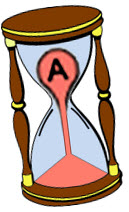 The problem: you’re not visible in Google Places and are considering one of two things: rolling up your sleeves to try to get visible yourself, or paying someone else to help you do it.
The problem: you’re not visible in Google Places and are considering one of two things: rolling up your sleeves to try to get visible yourself, or paying someone else to help you do it.
In the first case, I assume you’d like to know how much time you’d need to set aside from running your business and devote to wrangling with Google Places. In the second case, if you hire someone to help get you visible, you probably want to know what exactly you’re paying that person to spend time doing for you.
I can’t say exactly how many hours it would take you or someone else to get your business visible in Google Places. It could be 2 or 12. The whole process could take 2 weeks or 4 months. It depends on many factors—like how competitive your local market is, how visible your business is today, the condition of your website, and (yes) your geographical location.
What I can tell you is how you or someone else should spend time trying to get your business visible. Success in Google Places requires that you pay attention to many factors, not just one. Time-management is crucial. If you don’t divvy up your time properly, you can’t do everything you need to get done—and you’re that much less visible to local customers.
Unfortunately, too many business owners waste time on things that get them nowhere in local Google. It’s not that these techniques are useless: more often it’s just that people spend too much time on the wrong stuff and too little time on what really counts.
I’ve got 4 pie charts for you. Two of them show you a percentage breakdown of exactly how you should divide up your time to get visible in Google Places—based on my experience, at least. The other two charts show how people usually do divide up their time—and how it goes to waste. (And those are the people savvy enough even to tackle Google visibility in the first place!)
Note: I’m NOT weighing the relative importance of each factor. Just because I say you should spend only 2% of your time on a given step doesn’t mean it’s not important. I’m strictly talking about the relative amount of time you (or someone else) should or should spend on each piece of the puzzle.
The pie charts should be pretty self-explanatory. If you want to know more about any one of the factors, just scroll down to the section that’s below all the charts.
How business owners often DO spend their
initial “get visible in Google” time
Main reasons why this isn’t effective use of time:
- Too much tinkering. Too many people waste time constantly fiddling around with their Google Places listing, in the hopes that they’ll stumble across some magical keyword that when included on the Places page will please the Google Gods (AKA the “algorithm). What’s more important is to make sure that you’ve deleted duplicate listings—i.e., that you spend more time on “data control.” Make sure your Places page info is accurate, claim your listing if you haven’t already, and don’t spend more time messing with it.
- Too many “website tweaks.” Many business owners overdo this. True: on-page website factors do matter to your Google Places ranking, but they’re only part of the puzzle. So write title tags, H1s, etc. that are relevant to your services, but don’t keyword-research them for hours. You won’t rank any more highly.
- Overemphasis on social media (Facebook, Twitter, etc.) can help you reach more customers once you’re visible to them, but they don’t help get you visible in the first place. They’re nice to take up later, but they’ll simply delay your local visibility if you devote significant time to them at first.
Now compare the above chart to this one…
How you should divvy up your time
when FIRST trying to get visible
Main reasons why this IS an effective use of time:
- You’re paying attention to more local-search ranking factors. Google pays attention to many factors when deciding how to rank you. If you’re taking the time to produce content and put it on your site, you’ll win points with Google, and you may even get linked to by other sites. Plus, if you set aside a little time from the start to ask customers for reviews, you’ll have reviews working in your favor sooner rather than later.
- More “data control.” This isn’t just limited to making sure you don’t have duplicate Google Places listings floating around: you also need to make sure that third-party sites like Yelp and CitySearch don’t have a bunch of duplicate listings for your business, and that all that info is 100% accurate and consistent from site to site. If you set aside a little more time to make sure that you don’t have duplicate listings on these sites and that all your info is correct, you’ll avoid having to mop up the messy data later (which can really hurt your ranking). An ounce of prevention is worth a pound of cure.
Typical time-management for
MAINTAINING visibility
Why many locally visible businesses don’t stay visible for long:
- They try to fix things that ain’t broke. Most business owners breathe a sigh of relief when they can see their businesses in the Google Places top-7. The trouble is they sometimes get a little greedy (which is understandable) and try to grab a slightly better ranking by tinkering too much with their Google Places pages and websites. Rarely does this actually help their rankings climb: constant tweaking usually accomplishes nothing or causes a drop in rankings. The other time bomb is this: people usually don’t know what else they should do for Google Places once they’re visible there, so they tend to turn their attention to social media—which doesn’t influence Places rankings significantly.
- They neglect customer reviews. Too many newly visible business owners, customer reviews suddenly aren’t a priority. It always takes a little elbow grease and shoe leather to ask your customers for reviews—even if you’ve done it a hundred times and know what you’re doing. But if you’re not sure how to get started and you know you’re basically visible already, the determination to ask customers for reviews tends to go the way of the New Year’s resolution.
Compare this “typical” time management to what’s in the following chart—which is how I suggest you spend your “maintenance” time:
Best ways to use your time to maintain and
grow your local visibility
- You’re setting aside a little time to produce content. Few business owners do this. I’m not talking about article-spinning or creating self-promoting videos that come across as little infomercials. I’m talking about stuff that helps inform your customers and answers questions that only you, the seasoned expert, can answer. It can be in the written word or video. In terms of your Google Places ranking, good website or blog content kills a ridiculous number birds with a few stones (just contact me if you want me to talk your ear off about this). If you’re already somewhat visible in Google Places, more good content is one of the very best ways to pull ahead of the remaining competitors and put some nails in their coffins. But it’s got to become a habit: something you keep up with over the long haul, and always carve out some time for.
- You’re taking the time to get reviews. You must set aside time for it while you’re visible and the phone is ringing: I guarantee you won’t feel like it if you’re freaking out because your Google Places visibility just tanked.
- You’re looking for more third-party sites to get listed on: the 10% spent on “gathering citations” should go to poking around online for sites specific to your industry (like The Minnesota Nursery & Landscape Association) or your local area or city (Austin360.com). In the same way, you’re also spending a little time looking for ways to garner some extra publicity—like in blogs or the local newspaper—which can give you a boost in local Google.
- You’re dotting your I’s and crossing your T’s: responding to customer reviews written on your Places page, brewing up coupons, keeping a foot in social media, etc. You’re not getting OCD over any of these items because you’re spending time focusing on the big stuff (like original content and reviews). You’ve turned your Google Places campaign into quite the lovely cornucopia.
More about the Google Places ranking
factors that compete for your time
Here’s a little more info about each factor, in case there were some you weren’t completely clear on:
![]() Researching your local market. Before you try to get visible in Google Places, you need to find out whether the search terms you want to get visible for actually trigger the local search results, see how many local competitors you have, use the Google Keyword Tool to find the most relevant and searched-for terms, etc. Look before you leap.
Researching your local market. Before you try to get visible in Google Places, you need to find out whether the search terms you want to get visible for actually trigger the local search results, see how many local competitors you have, use the Google Keyword Tool to find the most relevant and searched-for terms, etc. Look before you leap.
![]() Creating Google Places page/ Tweaking Places info. This is actually the quick part. If you spend a significant amount of time messing with your Google Places listing, you’re doing something wrong. Google doesn’t like frequent changes.
Creating Google Places page/ Tweaking Places info. This is actually the quick part. If you spend a significant amount of time messing with your Google Places listing, you’re doing something wrong. Google doesn’t like frequent changes.
![]() Gathering citations. The tedious process of listing your business on third-party sites. Crucial.
Gathering citations. The tedious process of listing your business on third-party sites. Crucial.
![]() Producing content. It’s smart to get some in-depth, informative articles for your site or blog. Good content can win you quality links without your even having to pester anyone. Or you can put together some short, purely informative, non-promotional videos that a potential customer would find helpful (see “Creating videos,” below).
Producing content. It’s smart to get some in-depth, informative articles for your site or blog. Good content can win you quality links without your even having to pester anyone. Or you can put together some short, purely informative, non-promotional videos that a potential customer would find helpful (see “Creating videos,” below).
![]() Data control. You need be on a constant crusade to remove duplicate listings, and to remove or fix any listings with incorrect info on your business. To do this you need to keep an eye on the listings that show up in your Google Places “Dashboard,” and you also routinely need to check your listings on third-party directories (like Yelp) and on major data-providers (like InfoUSA) .
Data control. You need be on a constant crusade to remove duplicate listings, and to remove or fix any listings with incorrect info on your business. To do this you need to keep an eye on the listings that show up in your Google Places “Dashboard,” and you also routinely need to check your listings on third-party directories (like Yelp) and on major data-providers (like InfoUSA) .
![]() Website tweaks. Optimizing title tags, description tags, H1s, etc. Business owners often hurt themselves by spending time trying to stuff keywords, or by constantly fiddling with these on-page factors. Use a real light touch on the search terms you include, write them with your customers in mind (not Google), and for God’s sake don’t keep changing them around.
Website tweaks. Optimizing title tags, description tags, H1s, etc. Business owners often hurt themselves by spending time trying to stuff keywords, or by constantly fiddling with these on-page factors. Use a real light touch on the search terms you include, write them with your customers in mind (not Google), and for God’s sake don’t keep changing them around.
![]() Asking for reviews. Customer reviews have become more and more important to your ranking—especially ones written through customers’ Google accounts. There are a number of ways you can drum up reviews, but whatever method(s) you choose, you need to keep at it for the long haul.
Asking for reviews. Customer reviews have become more and more important to your ranking—especially ones written through customers’ Google accounts. There are a number of ways you can drum up reviews, but whatever method(s) you choose, you need to keep at it for the long haul.
![]() Uploading pictures. It’s worth taking the time to put a few good ones on your Places page. It’s not worth constantly changing them or laboring over them to death.
Uploading pictures. It’s worth taking the time to put a few good ones on your Places page. It’s not worth constantly changing them or laboring over them to death.
![]() Searching for links. It’s a big Google Places ranking-booster to have links to your site from sites that are relevant to your industry and/or city. To get good ones requires some poking-around, even once you’ve created the good content that you’ll need to be able to offer in exchange for the links.
Searching for links. It’s a big Google Places ranking-booster to have links to your site from sites that are relevant to your industry and/or city. To get good ones requires some poking-around, even once you’ve created the good content that you’ll need to be able to offer in exchange for the links.
![]() Adding coupons and/or “Posts.” Coupons are always good, but extremely quick to create on your Places page. Same with the tiny, 160-character Posts—aka “real-time updates”—that you can add to your page (you can do this from the top-right area of your Places “Dashboard”). Still, neither of these is worth getting OCD over.
Adding coupons and/or “Posts.” Coupons are always good, but extremely quick to create on your Places page. Same with the tiny, 160-character Posts—aka “real-time updates”—that you can add to your page (you can do this from the top-right area of your Places “Dashboard”). Still, neither of these is worth getting OCD over.
![]() Social media. Good in small doses, but not worth too much of your time, especially if your goal is to attract customers through Google Places.
Social media. Good in small doses, but not worth too much of your time, especially if your goal is to attract customers through Google Places.
![]() Scouting competitors. See where their customers write them reviews, see the videos they’re adding to their Places pages, see what content they’re adding to their sites and providing for other sites, etc. Constantly type their names into Google, keep an eye on the Google Places and organic rankings, and above all see what you can learn from them.
Scouting competitors. See where their customers write them reviews, see the videos they’re adding to their Places pages, see what content they’re adding to their sites and providing for other sites, etc. Constantly type their names into Google, keep an eye on the Google Places and organic rankings, and above all see what you can learn from them.
![]() Creating video. Short videos that serve as little nuggets of helpful info, not little infomercials. They don’t need to be pretty, but they do need to be informative. Upload them to YouTube, then to your Google Places listing and your site.
Creating video. Short videos that serve as little nuggets of helpful info, not little infomercials. They don’t need to be pretty, but they do need to be informative. Upload them to YouTube, then to your Google Places listing and your site.
![]() Pursuing publicity. I’m talking about keeping your peepers open for chances to write a short article for your local paper, do an interview in which you’re the “expert,” participate in a local charity event—anything. Good publicity can win you links and/or citations, both of which can help your ranking big-time. This needs to be an ongoing habit.
Pursuing publicity. I’m talking about keeping your peepers open for chances to write a short article for your local paper, do an interview in which you’re the “expert,” participate in a local charity event—anything. Good publicity can win you links and/or citations, both of which can help your ranking big-time. This needs to be an ongoing habit.
![]() Running tests. Test coupons. Test different ways to ask your customers for reviews. Try other unconventional experiments. This is how you find the best ways to stay visible and get the phone to ring more and more.
Running tests. Test coupons. Test different ways to ask your customers for reviews. Try other unconventional experiments. This is how you find the best ways to stay visible and get the phone to ring more and more.
![]() Running SEO analyses. You need to keep your site ship-shape. WebsiteGrader.com is a good way to do this. So is keeping an eye on Google Analytics and Google Webmaster Tools data.
Running SEO analyses. You need to keep your site ship-shape. WebsiteGrader.com is a good way to do this. So is keeping an eye on Google Analytics and Google Webmaster Tools data.
![]() Responding to reviews. You can log in to your Google Places listing and respond to reviews that customers have written through their Google accounts. Reply to the positive ones, too, not just the duds.
Responding to reviews. You can log in to your Google Places listing and respond to reviews that customers have written through their Google accounts. Reply to the positive ones, too, not just the duds.
—
Time-management is tricky in Google Places. On the one hand, you have to juggle tons of balls (and a few chainsaws and torches) in order to get visible to local customer, and especially to stay visible. On the other hand, you can’t spread yourself too thin and neglect the items that really reward a little extra investment in time.
I hope the pie charts help you get more bang for your hour. Or, alternatively, I hope they better enable you to breathe down your local-search expert’s neck and make sure you get your dollar’s worth 🙂
What factors would YOU add to the pie charts? How would you tweak the size of some of the “slices”? Leave a comment!
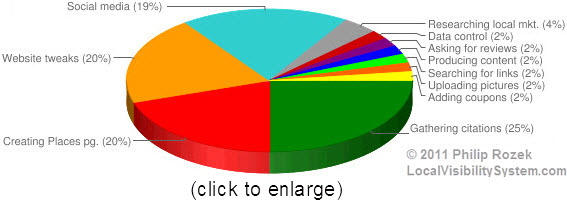
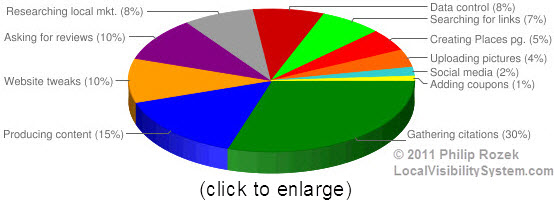
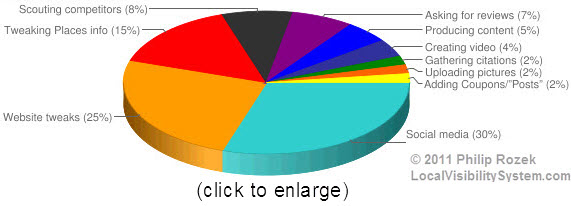
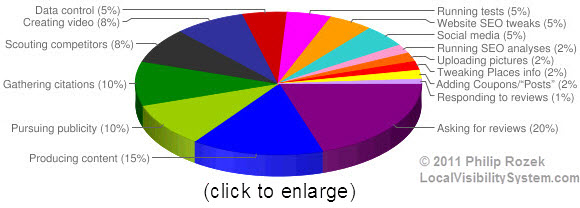
That some great piece there Phil!
While it is true that SMBs have bad time management for their online marketing, I think some of the numbers you quoted have to be increased, while others – slightly decreased.
I think research (especially competitors research) and creating content, especially in the preliminary stage are extremely important, and I would stress on these the most. Furthermore, I think a lot of attention should be placed in the beginning on the setting up of the Place page itself + research on the current data that is online for the particular business. Researching and trying to get good links in the start up stage is also a big must. So I’d put the most on these.
In the later stage, I believe reputation management and monitoring are the most important, as well as maintenance and monitoring of the performance of the website and Place page.
Generally, that’s a truly super article. Really incredible content.
Greetings,
Nyagoslav
I totally agree that competitive-intel/research is crucial to do, especially up-front. That’s why I suggest people spend a good chunk of their time (8%) on it, rather than what I’d say is the amount most people spend on it (about half that). But, as I said, just because I give competitive-research 8% and “producing content” 15% doesn’t mean I think the former is only half as *important* as the latter: I think we’d both agree that for some people competitive-intel can be very quickly done, and that a little bit can go a very long way.
Same for getting early links: I completely agree. That’s why I say people should be producing content right out of the gates, because no matter how hard or how many people you ask, nobody’s who is anybody is going to link to you unless you’ve got the content.
I should probably add rep-management as a category–that’s a great suggestion.
Thanks for all your great suggestions and feedback!
Very interesting and helpful break down, thanks. It is very easy to get caught up and spend to much time on an element that holds little overall value a listings ranking position.
Regarding the maintaing and growing pie chart. I feel scouting competitors should be have a little more dedicated time just because it is more time consuming than ever since the update caused the listings to no longer display citations.
Thanks again for the article, well done.
Thanks for the compliments. Yeah, I see what you mean about having to spend a lot of time scouting. In highly competitive markets, I absolutely agree that you’d need to spend even more time on it, but it can be kind of a quick deal in average to less-competitive ones. Maybe if people can spend 30-60 minutes every month looking for more citations (after they’re more or less visible in GP), their visibility would stay in pretty good shape.
I’ll certainly have to do the piecharts again next year, by which time I’m sure Google will have changed even more. I’d certainly be interested in more suggestions as to how to change the “slices.”